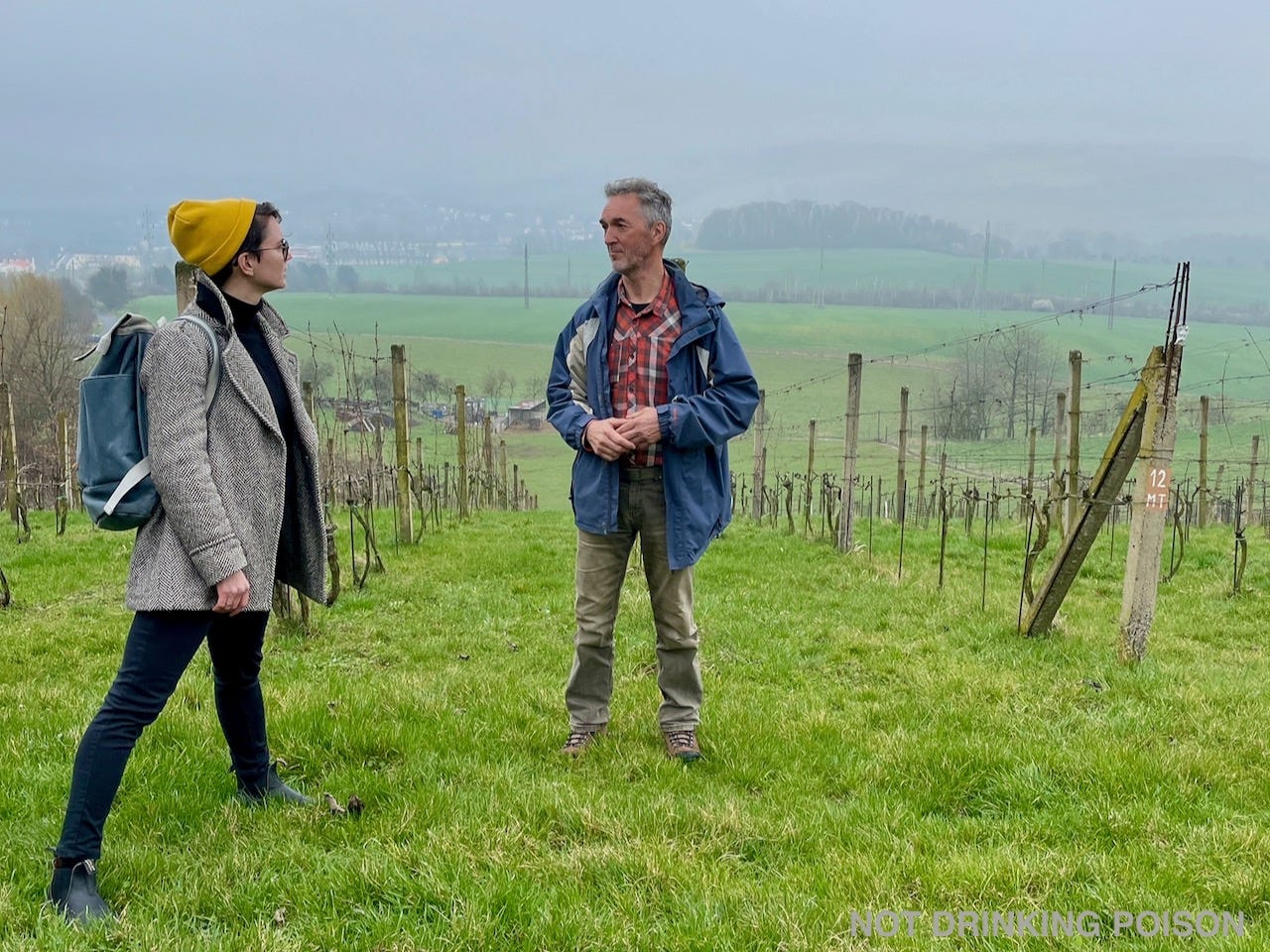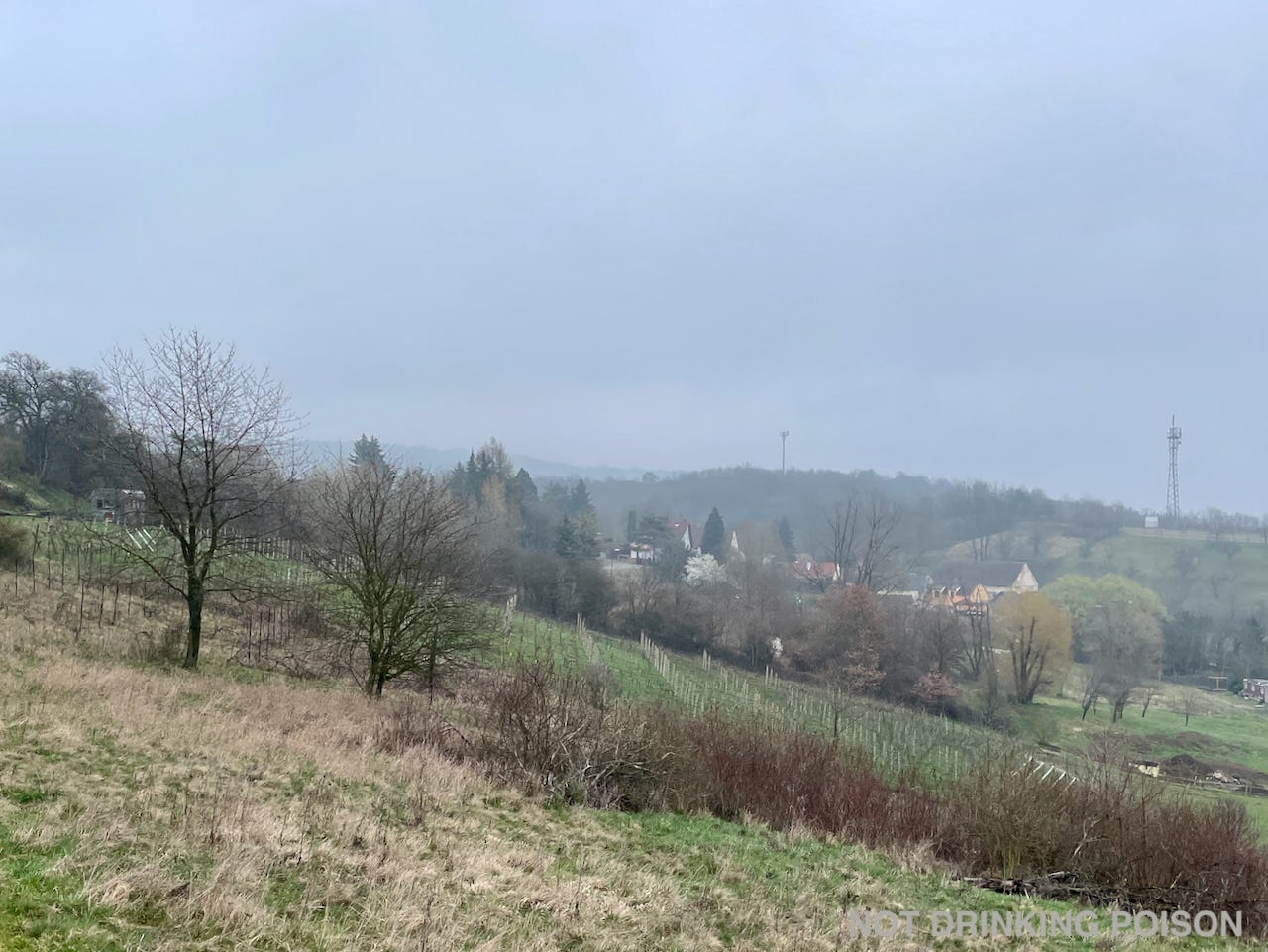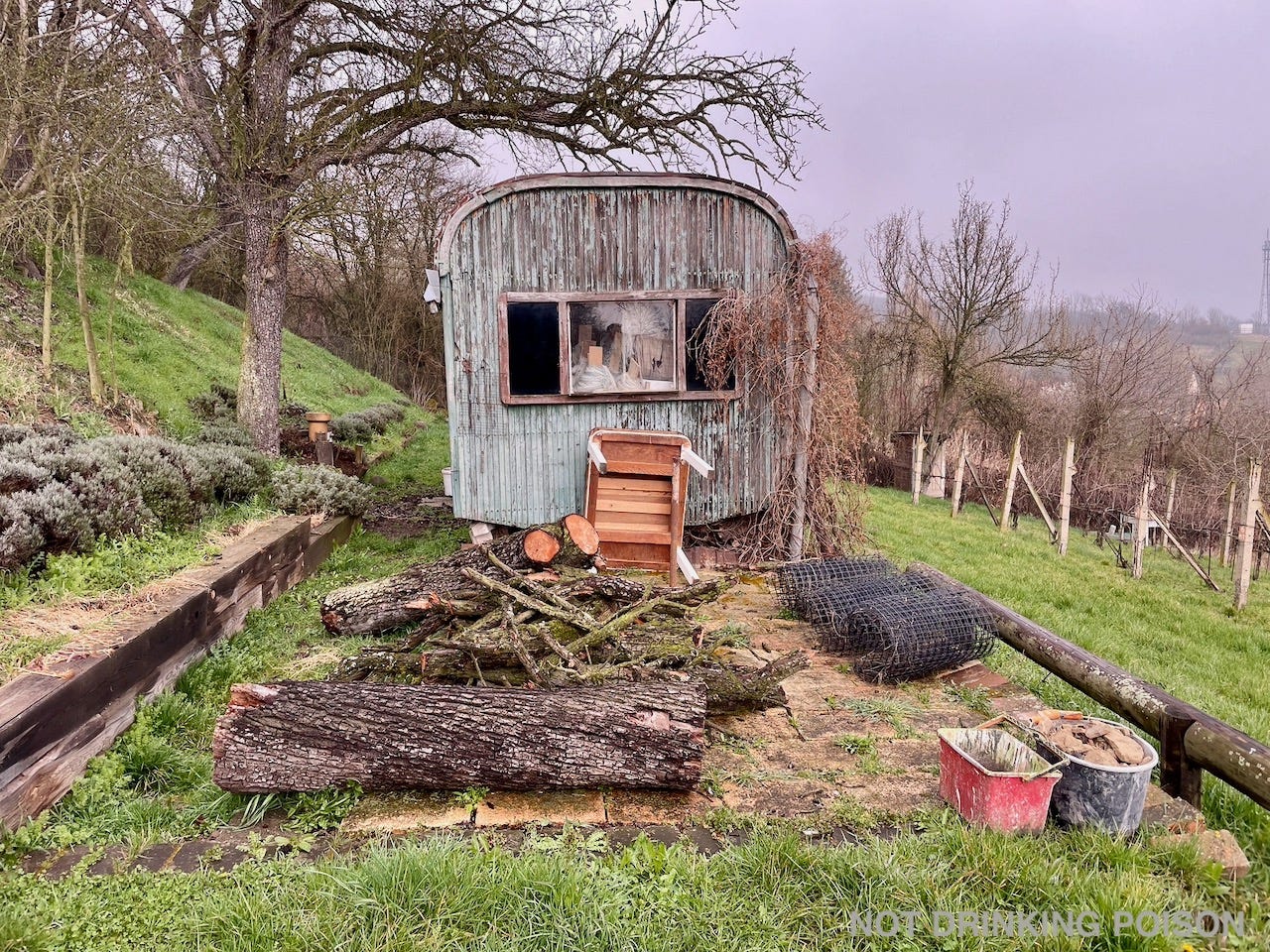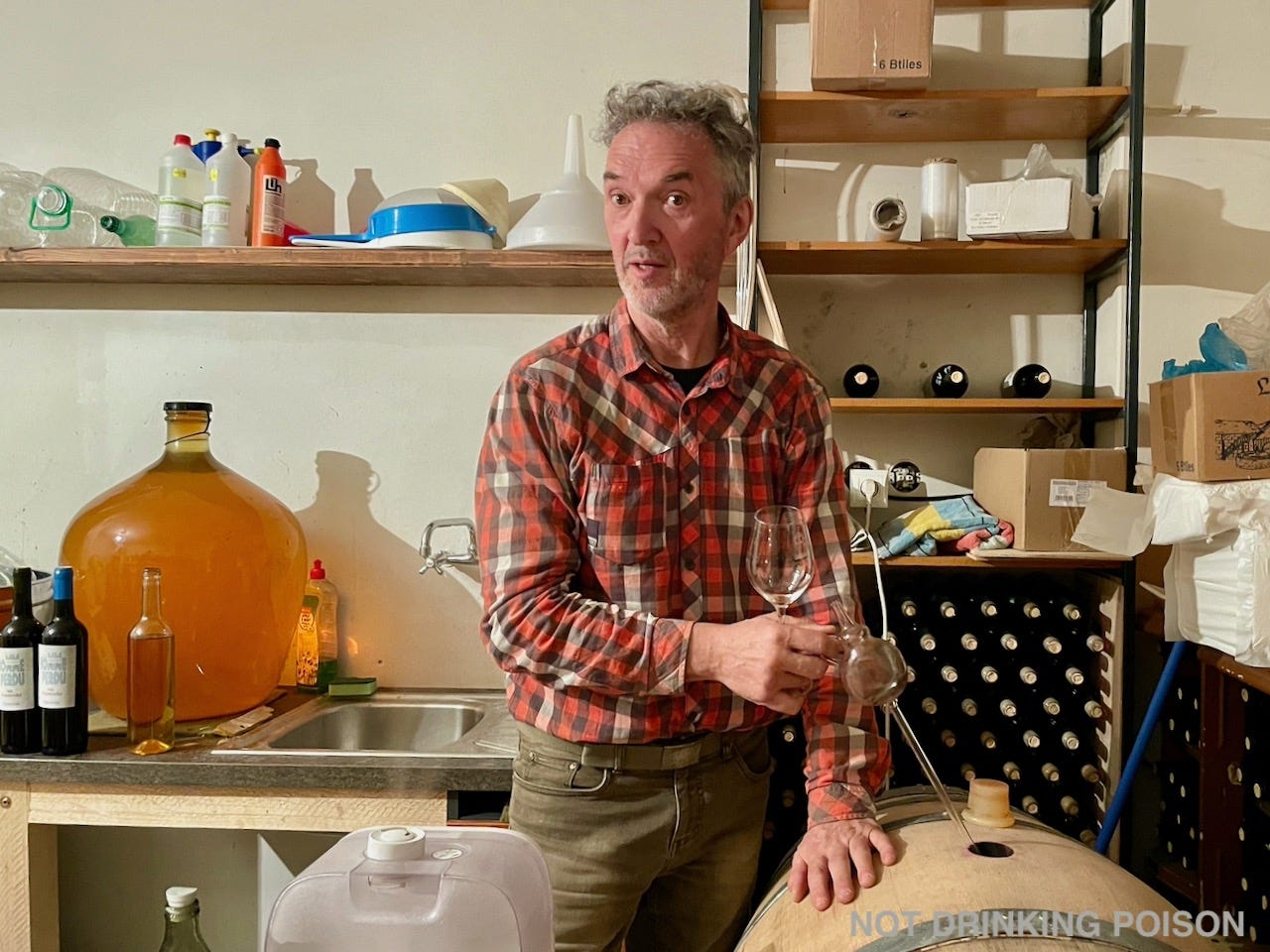Not All Who Wander: L'Homme Perdu
Bohemia vigneron Pavel Tománek deploys dried grape infusions and long barrel aging to produce radical, anachronistic natural wine at the northernmost limit of Czech viticulture.
Bohemia vigneron Pavel Tománek is a retired ceramicist who in 2016 began farming a tiny 0.4ha parcel outside the town of Řehlovice, near the German border south of Dresden. An avowed Francophile, he calls his winery L’Homme Perdu - “the Lost Man” - in reference to his isolation from winemaking circles in Ústí nad Labem, the downtrodden industrial city where his cellar is located.
During my visits to the Czech Republic, several winemakers invoked a disappearing, Soviet-era culture of non-commercial, family wine production. Tománek’s free-thinking, oddly innovative work - manifestly a labor of love - comes close to an example of such winemaking.
I met Tománek in late March in the course of an afternoon tasting organized by his friend and fellow Bohemia vigneron Bogdan Trojak at the latter’s harvest shack. Struck by the peculiar stylistic approach of Tománek’s winemaking - and its evident purity - I arranged to visit his vineyard and cellar the following day in the company of my friend Lucie Kohoutová, who kindly acted as translator.
Quick Facts
Tománek farms a total of 0.6ha, of which 0.4ha are presently in production. (He recently planted 0.2ha beside the vineyard of his friends Bogdan Trojak and Salome Khardzeishvili in Velké Žernoseky.)
He sprays sulfur just once per season; no copper is used. All vineyard work is manual, without machines of any kind. He does not plow his soils, maintaining grass cover year-round. He combats mildew and oidium chiefly through a maniacal regimen of leaf-pulling that begins immediately after flowering.
Grapes farmed include frankovka (blaufrankisch), zweigelt, müller thurgau, riesling, muscat, saint laurent, and alibernet.
Tománek’s cellar is at his home in the industrial city of Ústí nad Labem, where he formerly ran a small wine shop. He employs a manual press; no additives or filtration or fining of any kind are employed in vinification. Whites macerate from a few days to a few weeks before pressing; almost everything is destemmed.
Generally, all wines age two years (!) in oak or acacia barrel, and a further year in bottle before release.
In what is perhaps his most peculiar practice, Tománek dries a portion of the harvest each year, using it later to infuse the fermenting musts of the following vintage. His most striking wine is a crémant produced in this manner; the bottle contains the bobbing grape berries that were added to initiate secondary fermentation.
Tománek’s work producing radical natural wine in hilariously adverse conditions at the northernmost limit of Czech viticulture is at once cutting-edge and curiously anachronistic. His are impeccably pure, low-yield, cold-climate, low-alcohol wines that are also very extractive and oak-influenced.
Total production is about 1000 bottles each year.
THE LOST MAN
“Someone should make a documentary film about him,” I remark, as we race south through a rainstorm after our tasting with Bohemia vigneron Pavel Tománek. We are running late to dinner with friends in Tábor, south of Prague.
I steer through the rain on the highway and wonder what such an endeavor would involve.
You would have to follow Tománek’s vineyard work throughout the seasons.
That afternoon the fields were too wet to drive through, so we walked fifteen minutes to his 0.4ha parcel of frankovka, zweigelt, müller thurgau, riesling, muscat, saint laurent, and alibernet. The parcel belongs to the owner of the small farm downslope. It sits on the upper slope of a hill marked by a vein of a powdery, degraded volcanic ash just below the topsoil.
Tománek showed me an image on his phone of what the horizon looks like on a clear day, marked by Bohemia’s volcanic hills. That March afternoon we saw only fog.
This sector of Bohemia is apparently, and rather cruelly, subject to both drought and constant fog. Preferring not to treat with copper, Tománek prevents mildew with a fastidious regime of leaf-pulling that begins right after floraison.
The documentary would have to include this: hours spent micro-managing the canopy of his tiny parcel each day.
His vine training is strung with repurposed plastic soda bottles, which upon closer inspection turn out to contain the mass-graves of wasps, drowned in sugar solution. He usually takes the makeshift traps away after harvest, but he forgot last year. His vines bear the only significant source of fruit of any kind within a fifteen-kilometer radius, with the result that they attract swarms of wasps. And birds. His toolshed above the vineyard contains black netting that he laboriously strings down the rows late in the season to protect his tiny harvest from birds.
The documentary would include all this, too. There would be close-ups on the grape bunches beneath the netting. A voiceover would note how meagre the fruit load is to begin with - the vineyard is unplowed and unfertilized - and the bunches’ minimal ripeness. Elsewhere in Europe, in September and October, harvest comes and goes, and Tománek is still defending against wasps and birds, awaiting greater maturity.
“The yields get lower and lower over the years, but the grapes get better and better,” he told us. “They have more extract, more flavor, more interest, more complexity.”
Tománek typically harvests in early November, allowing portions of alibernet to hang until the end of the month. The documentary would record Tománek placing those extremely late-harvest grapes into wooden bins in his work shop, where they begin drying.
Tománek’s drying process is slow and convoluted, lasting the course of a year. In the summer, when whether permits, he puts the bins of drying grapes into the sun in his backyard.
The documentary would follow Tománek back to Ústí nad Labem, into his tidy cellar, which appears to have once been the laundry room on the ground floor of his home. A humidifier puffs away beside a row of barrels.
Tománek ferments and ages his wines two years in a mix of oak and acacia of varying provenance - France, Slovenia, even, improbably, America. Many musts see the addition of dried grapes from the previous vintage, a sugar addition that raises their alcohol level to, usually, around 12%. (The 2019 Frankovka is an outlier; it was the first year he experimented with adding dried alibernet and he misjudged the dose, raising the finished wine to an anomalous 14.5%.)
Tománek says him aim with these apassimento infusions is not to add sugar or ripeness. He just wants to see what it does. But, taken alongside his professed love for visiting the Languedoc (he mentioned a particular appreciation for the vin doux naturel AOP Maury), its hard not to interpret his winemaking style as a touching attempt to recreate certain Mediterranean qualities in his north Bohemian wines.
“In my experience, cool-climate reds need a shock of long maceration and oak at the start,” he told us. “Since I age it for a while, the wine digests it.”
The most convincing support for Tománek’s theory is his 2018 frankovka. In its lingering oak tones and its artfully patinated volatility, it shares a stylistic kinship with certain pineau d’aunis wines from Renaud Guettier or Jean-Pierre Robinot. With aeration, a basaltic, angular fruit emerges, evoking the pinot noir of Patrick Bouju. A frequent traveler to France, Tománek jokes that his wines are S.A.I.N.S. - sans aucun intrant ni sulfites (ajoutés), although he is not an official member of that association.
Wines tasted from barrel, and several from bottle, seem to struggle under the weight of wood aging. The documentary would surely have to follow Tománek on one of his solo sojourns through France, sharing his wines on the outskirts of natural wine salons.
“It’s been a journey towards understanding where I am,” he told us. “I used to age wines only in stainless steel and glass. I felt the wine was lacking something. I tried oak to add the missing piece. The wines feel better, more round, more whole.”
More crowd-pleasing, but no less unique, was a bottle of crémant Tománek opened the previous evening among friends at Veltlin in Prague.
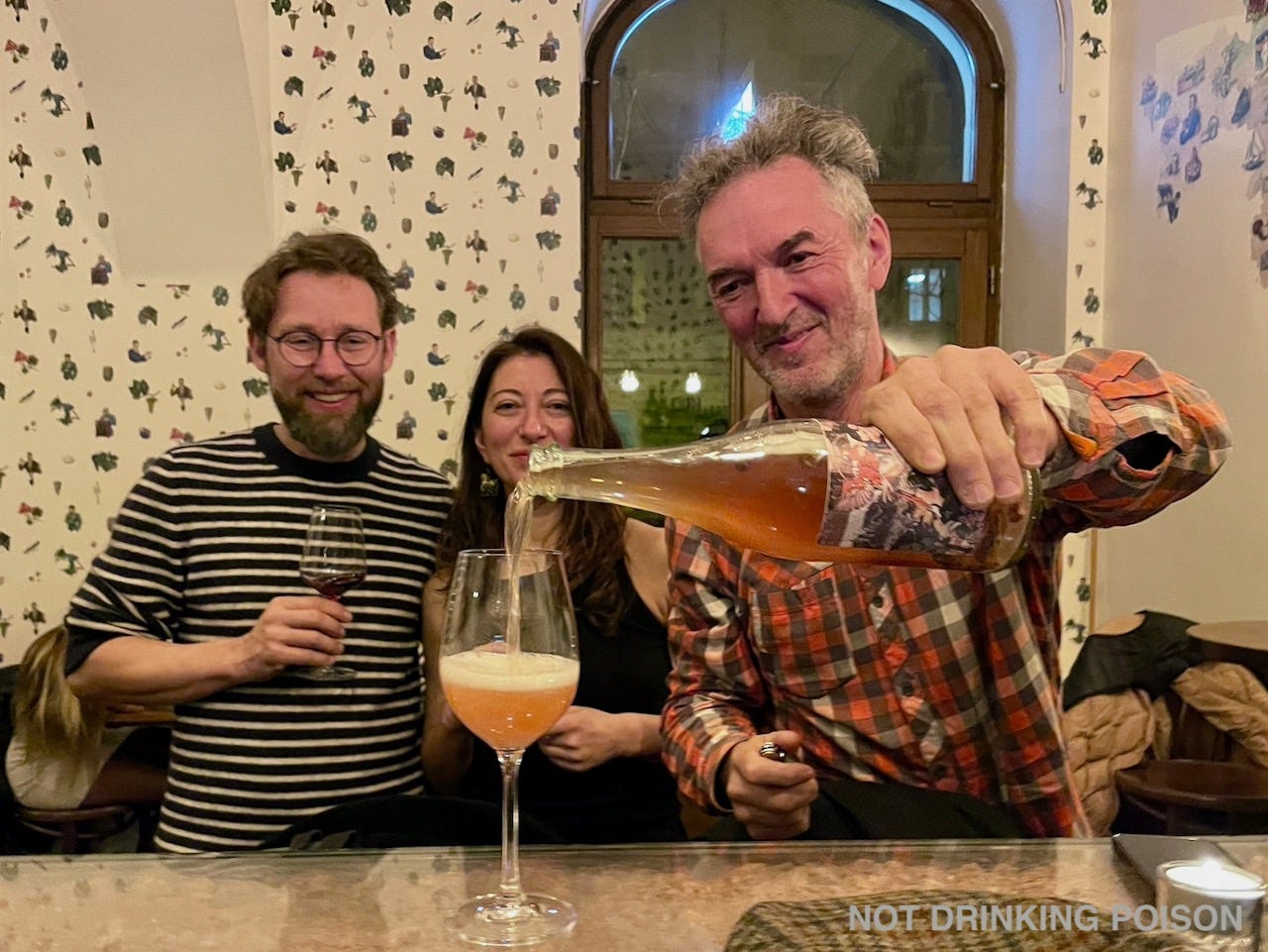
It was 2022 muller thurgau juice fermented to dryness and rendered sparkling with the addition of dried alibernet berries from the 2021 harvest. Balanced, ample, with a pleasing whipcrack of volatility, the wine represented an ingenious way to transform north Bohemia’s wild acidity and minimal maturity into something immediate and pleasurable.
But Tománek is in no hurry. He produces just a thousand bottles each year, waiting five more years, in most cases, for them to become drinkable. The documentary would show him fiddling with a home printer to produce the labels, which, in recent years, depict zebras, motorcycle helmets, and triumphing skiers.
“For me, it’s very important that a winemaker keep his personal freedom. To not become a slave of your wine or your success,” he told us in his cellar. “Often people realize they’re successful, and they start to make more and more wine, and the pleasure goes out of it - and out of their life, too.”
The documentary would also follow Tománek into Prague, sharing wines at Veltlin with his friends, sleeping on their floors before returning to Ústí nad Labem in the morning.
“I realize this because I’m an old man,” he added. “If I was young, I’d probably do the same thing and push myself very hard.”
There is a tendency, when one encounters outsider-artist winemakers like Tománek, to conclude, on the basis of their minuscule production, their computer-printed labels, their indifference to prevailing tastes, that they are just not ready for prime time. True enough, in itself. I suppose the documentary I have in mind, as we enter traffic on the outskirts of Tábor, would suggest the value of exploring what lies necessarily outside the purview of prime time.
The documentary might end outside Tománek’s cellar, on the side streets of Ústí nad Labem, in a local tavern below where the film crew have been staying, where no one is drinking any wine whatsoever.
Pavel Tománek - L’Homme Perdu
Emy Destinové 12
40001 USTI NAD LABEM-MESTO
Czech Republic
FURTHER READING
A visit to Bohemia vigneron and Czech natural wine pioneer Bogdan Trojak.
A visit to Bohemia vigneron (and scientist) Aleš Svatoš.



